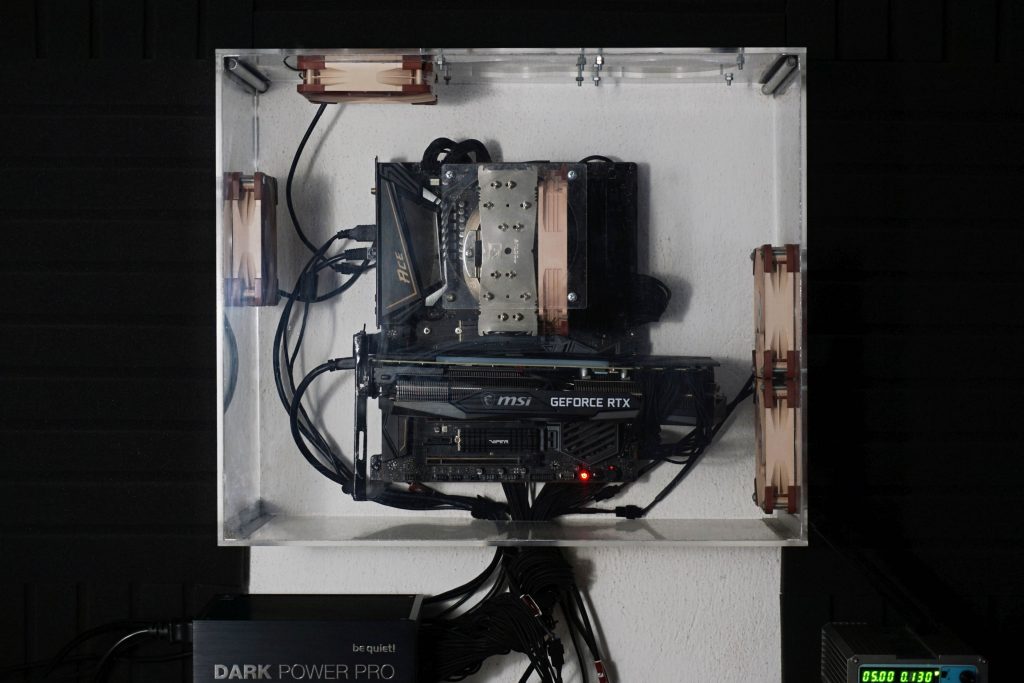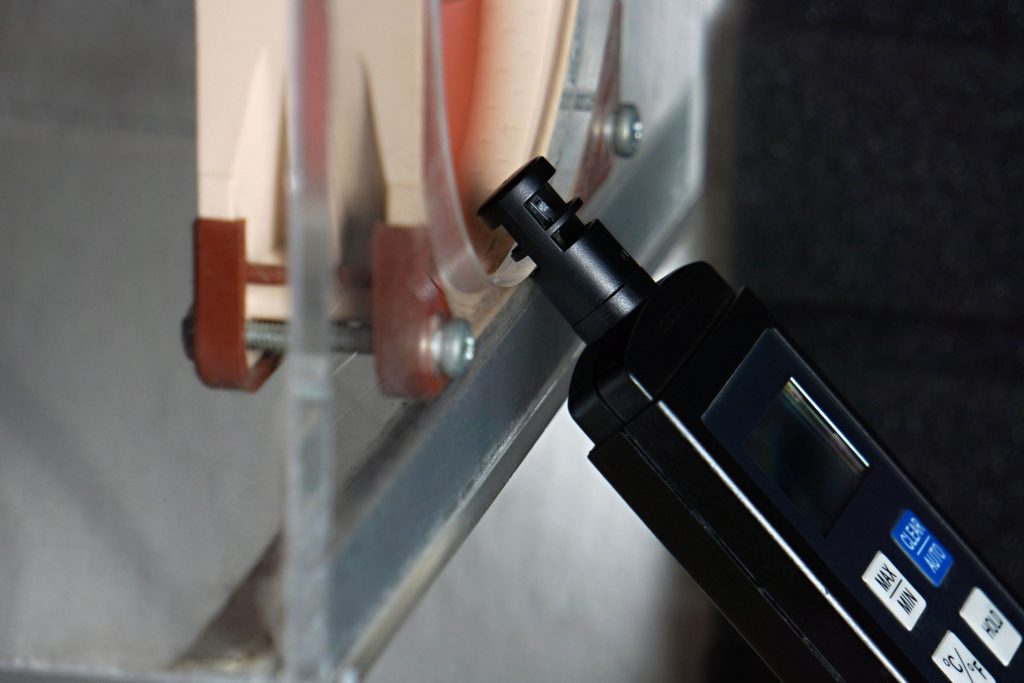Methodology: temperature and clock speed tests
AMD’s first processor with 3D V-cache is a rather controversial piece of hardware. Sure, it may be the ultimate in gaming performance, but the desired effect is more “on paper” than practical, and when it does come, it’s in very rare cases. So that you don’t end up disappointed with a virtually single-purpose processor that may not even excel at gaming, we’ve broken it all down in detailed tests.
Methodology: temperature and clock speed tests
When choosing a cooler, we eventually opted for Noctua NH-U14S. It has a high performance and at the same time there is also the TR4-SP3 variant designed for Threadripper processors. It differs only by the base, the radiator is otherwise the same, so it will be possible to test and compare all processors under the same conditions. The fan on the NH-U14S cooler is set to a maximum speed of 1,535 rpm during all tests.
Measurements always take place on a bench-wall in a wind tunnel which simulates a computer case, with the difference that we have more control over it.
System cooling consists of four Noctua NF-S12A PWM fans, which are in an equilibrium ratio of two at the inlet and two at the outlet. Their speed is set at a fixed 535 rpm, which is a relatively practical speed that is not needed to be exceeded. In short, this should be the optimal configuration based on our tests of various system cooling settings.
It is also important to maintain the same air temperature around the processors. Of course, this also changes with regard to how much heat a particular processor produces, but at the inlet of the tunnel it must always be the same for accurate comparisons. In our air-conditioned test lab, it is currently in the range of 21–21.3 °C.
Maintaining a constant inlet temperature is necessary not only for a proper comparison of processor temperatures, but especially for unbiased performance comparisons. Trend of clock speed and especially single-core boost depends on the temperature. In the summer at higher temperatures, processors may be slower in living spaces than in the winter.
For Intel processors, we register the maximum core temperature for each test, usually of all cores. These maximum values are then averaged and the result is represented by the final value in the graph. From the outputs of single-threaded load, we only pick the registered values from active cores (these are usually two and alternate during the test). It’s a little different with AMD processors. They don’t have temperature sensors for every core. In order for the procedure to be as methodically as possible similar to that applied on Intel processors, the average temperature of all cores is defined by the highest value reported by the CPU Tdie sensor (average). For single-threaded load, however, we already use a CPU sensor (Tctl/Tdie), which usually reports a slightly higher value, which better corresponds to the hotspots of one or two cores. But these values as well as the values from all internal sensors must be taken with a grain of salt, the accuracy of the sensors varies across processors.
Clock speed evaluation is more accurate, each core has its own sensor even on AMD processors. Unlike temperatures, we plot average clock speed values during tests in graphs. We monitor the temperature and clock speed of the processor cores in the same tests, in which we also measure the power consumption. And thus, gradually from the lowest load level on the desktop of idle Windows 10, through audio encoding (single-threaded load), gaming load in three games (F1 2020, Shadow of the Tomb Raider and Total War Saga: Troy), to a 10-minute load in Cinebench R23 and the most demanding video encoding with the x264 encoder in HandBrake.
To record the temperatures and clock speed of the processor cores, we use HWiNFO, in which sampling is set to two seconds. With the exception of audio encoding, the graphs always show the averages of all processor cores in terms of temperatures and clock speed. During audio encoding, the values from the loaded core are given.
- Contents
- AMD Ryzen 7 5800X3D in detail
- Methodology: performance tests
- Methodology: how we measure power draw
- Methodology: temperature and clock speed tests
- Test setup
- 3DMark
- Assassin’s Creed: Valhalla
- Borderlands 3
- Counter-Strike: GO
- Cyberpunk 2077
- DOOM Eternal
- F1 2020
- Metro Exodus
- Microsoft Flight Simulator
- Shadow of the Tomb Raider
- Total War Saga: Troy
- Overall gaming performance
- Gaming performance per euro
- PCMark and Geekbench
- Web performance
- 3D rendering: Cinebench, Blender, ...
- Video 1/2: Adobe Premiere Pro
- Video 2/2: DaVinci Resolve Studio
- Graphics effects: Adobe After Effects
- Video encoding
- Audio encoding
- Broadcasting (OBS and Xsplit)
- Photos 1/2: Adobe Photoshop and Lightroom
- Photos 2/2: Affinity Photo, Topaz Labs AI Apps, ZPS X, ...
- (De)compression
- (De)cryption
- Numerical computing
- Simulations
- Memory and cache tests
- Processor power draw curve
- Average processor power draw
- Performance per watt
- Achieved CPU clock speed
- CPU temperature
- Conclusion











You have the 5800x’s launch price as $299 when it was actually the same as the 5800x3d’s at $450. You have the 5800x as coming with a AMD Wraith Stealth cooler when it didn’t come with a cooler. These are just things that immediately stood out to me and I haven’t checked further. The article seems fairly detailed, but apparently with the wrong details and I have to ask myself why such obvious things are wrong. There’s a reason why these details are wrong that appear to me to not be because of simple mistakes. It’s almost like you’re going out of your way to make the 5800x3d look bad.
Thanks for the heads up, you are correct, we have two factual errors in the chart. But I’m sure it would be a big mistake to condemn the rest of the article because of them. I make charts at the end, often at the end of my rope. It is very difficult to edit such a voluminous article with so much information, especially considering how small the editorial team is (tests of much larger editorial offices are usually a quarter the size of ours…). So now and then a mistake can happen. The Wraith Stealth cooler in the R7 5800X specs is an error that was caused by cloning the chart from a non-X model, after which the cooler was left there due to an oversight.
And yes, the launch price of the R7 5800X, of course, is not 299 USD, but 449 USD. So yes, this information was also incorrect in the original chart, but know that the goal was definitely not to put R7 5800X3D at a disadvantage. Again, I’ll explain how this came about. In all tests we use the same template and in the R7 5800X test we have something like “Launch price:
449299 USD” in the chart, which hopefully makes it clear that the crossed out price is the launch price and the second amount is the price after discounting. Here the amount dropped out and it looks really strange, but at the same time at the time of writing the article 299 USD corresponded to the suggested price (the one after discounting) by AMD. In order to make everything right, we’re putting back the original wording “449299 USD” with a note (below the chart) that explains that this is the price after discounting, which we’re reflecting. It would be impractical to work with the same launch price of the R7 5800X and the R7 5800X3D in the test case, as the market situation is different.So hopefully it makes a little more sense to you and you will reconsider that this could perhaps be deliberate manipulation. Everything has been corrected and thank you again for your observation and for reading carefully.